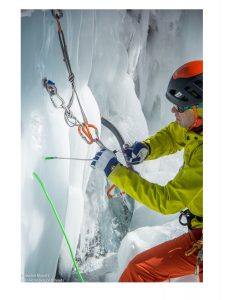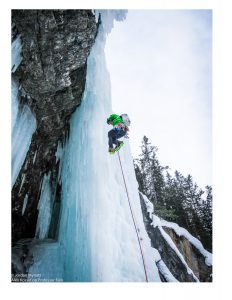10 Tips for Taking the Ice Instructor Course in Canmore | Jordan Mynatt
Jordan Mynatt | 2019 Petzl Scholarship Recipient
The pressure to be prepared for an AMGA course is stressful but valuable. We have a lot tied up in finances, training time and transportation that pushes us to perform well, but the element of the unknown can be debilitating. Here are a few tips that may help with the pre-course jitters for the Ice Instructor Course.
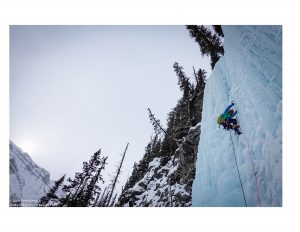
#1 Pick an Unfamiliar Venue
Make it worth your while by traveling somewhere you haven’t been before. This may feel like added stress, but in terms of reward and satisfaction, a new location can heighten learning ability. If you are nervous about the on-sight, then do your research in advance. Connect with someone who has climbed in the area or better yet, allow for a couple days in advance of the course to get familiar with the lay of the land and to acclimate. The first day I showed up in Canmore, the temperate dropped to -39º Celsius or Fahrenheit, you pick. Getting a guidebook early is also helpful. With the guidebook in hand, the pre-trip planning goes smoother and is one less thing to stress about once you get there.
#2 Guidebook & Local Resources for Canmore
The App, Ice and Mixed:Western Canada by Will Gadd compiles Joe Josephson’s Waterfall Ice Climbs in the Canadian Rockies guidebook into a user friendly app. The routes are organized by the Avalanche Terrain Exposure Scale (ATES) with color coding: green for simple, blue for challenging and black for complex. Despite a few glitches in the search function for the route descriptions, overall the App is a good orientation to the area. The mapping tools show the nearest climbing and the blue GPS dot keeps you on track for the approaches.
In preparing each day for your objective, Ice Lines—Select Waterfalls in Canadian Rockies by Brent Peters, has more up to date information and good pitch layouts. All of the climbs that we did in the course are in this book.
Many local resources are in place to check avalanche conditions and weather. The visitor safety dispatch gives current condition reports for specific areas in addition to what has been posted online. See below for the links.
- Avalanche Conditions Resources
- avalanche.ca
- Visitor Safety Dispatch 403-762-1473
- Weather Resources
- https://weather.gc.ca/canada_e.html
- https://www.avalanche.ca/weather/forecast
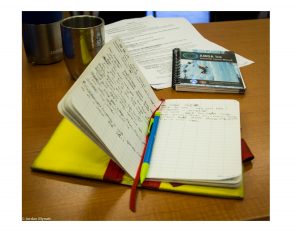
#3 Pre-Trip Conditioning
Ice climbing may not be your primary winter sport. Devoting time to focus on specific training like hanging from your ice tools a few minutes a day will go a long way to awaken the right muscle groups and build endurance. However, there is no substitute for climbing and it is essential to find time to get out. After playing around on desperate ice in WA this winter, I realized that a quick trip to Bozeman to get in a few back to back days was needed. This helped with conditioning as well as shaking down the gear with enough time prior to the course to place any last minute orders. Don’t forget the mental preparation. Watch the AMGA videos and get familiar with the current techniques and styles.
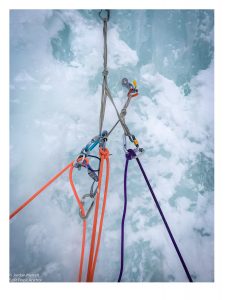
#4 Update Your Gear
After spending a chunk of money taking the course, you may find it hard to spend more cash on gear but updating your kit has several advantages. Beyond instructors disliking worn out gear you probably shouldn’t be using it. Bringing things up to speed can be a performance enhancer as well. Updating my early 2000’s crampons to the Petzl DART mono-points really improved my footwork. An additional side effect is you’ll be set for the next decade. A good quality small diameter dry rope like the Volta Guide 9.0, is also a worthwhile investment. Ice screws are easily borrowed within the group if your budget stops the spending spree. Make sure what screws you do have plus ice tools and crampons are all sharp before you leave home. Label your stuff! This is not your first AMGA course and you know the inevitable intermingling of gear. Sorting your gear quickly is helpful for everyone.
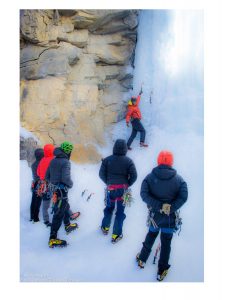

#5 Group Coordination
Advance communication with your team allows you to make good use of any pre-course time and to start building positive relationships. Coordinate with your group to see who is interested in an AirBnB. This also has the advantage of evening trip planning, meal sharing and carpooling. We were able to share a sizable condo with four people, making it ~$30 per person per night. Canmore is cold and urban, not an easy place to sleep in your car. Also, being able to dry out your gear at night could be clutch for success.
#6 Team Dynamics
These courses pull us from all over the country with varying climates, topography and guiding styles. No matter where someone is in their guiding progression they always have something to offer. Be open and respectful and you might learn something you didn’t expect. To maximize time with each instructor and gear organizing efficiency, we remained paired with the same partner for the week. Take the posture that you are a team. Making your partner look good will benefit you in the long run. Confidence overrides the need to elevate yourself. When you make a mistake, you will want your partner to have your back as well.
#7 Make Quality Use of the Daily Commute
One of the perceived drawbacks of the Canmore venue is the long commutes. I actually found this beneficial as it allowed time for constructive AM & PM meetings as well as debriefs in the comfort of a warm car. The downtime in the commute helps give a breather before the day and is a great chance to connect with seasoned IFMGA guides on a more personal level to explore the ups and downs of guiding. It is interesting to hear about their careers and how they have made it all work or just to hear about a new climb or route that you haven’t done.
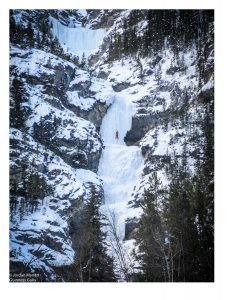
#8 Don’t Get Scooped
Whether you are showing up in advance to climb before the course or you are in charge of the meeting time during the course, start early. There’s a reason the objectives that you are picking are in the selected climbs book. They are classic and can be crowded, especially on the weekends. Climbing beneath other parties may not be an option for many climbs and on those that might be conceivable, it can add an unwanted stress to the course environment. Most days we picked our instructor up at 6:30 AM, pre daylight and never had any issues.
